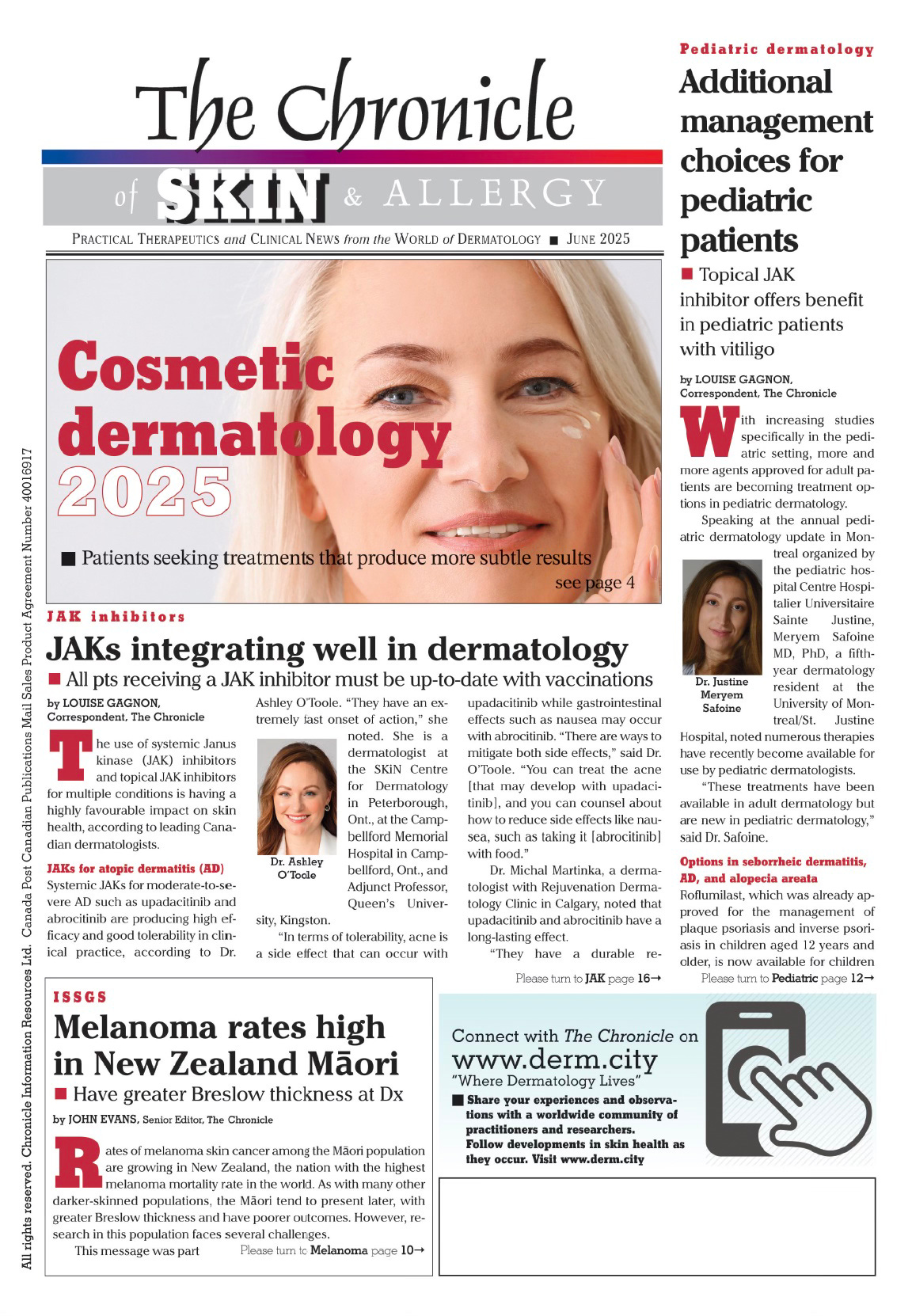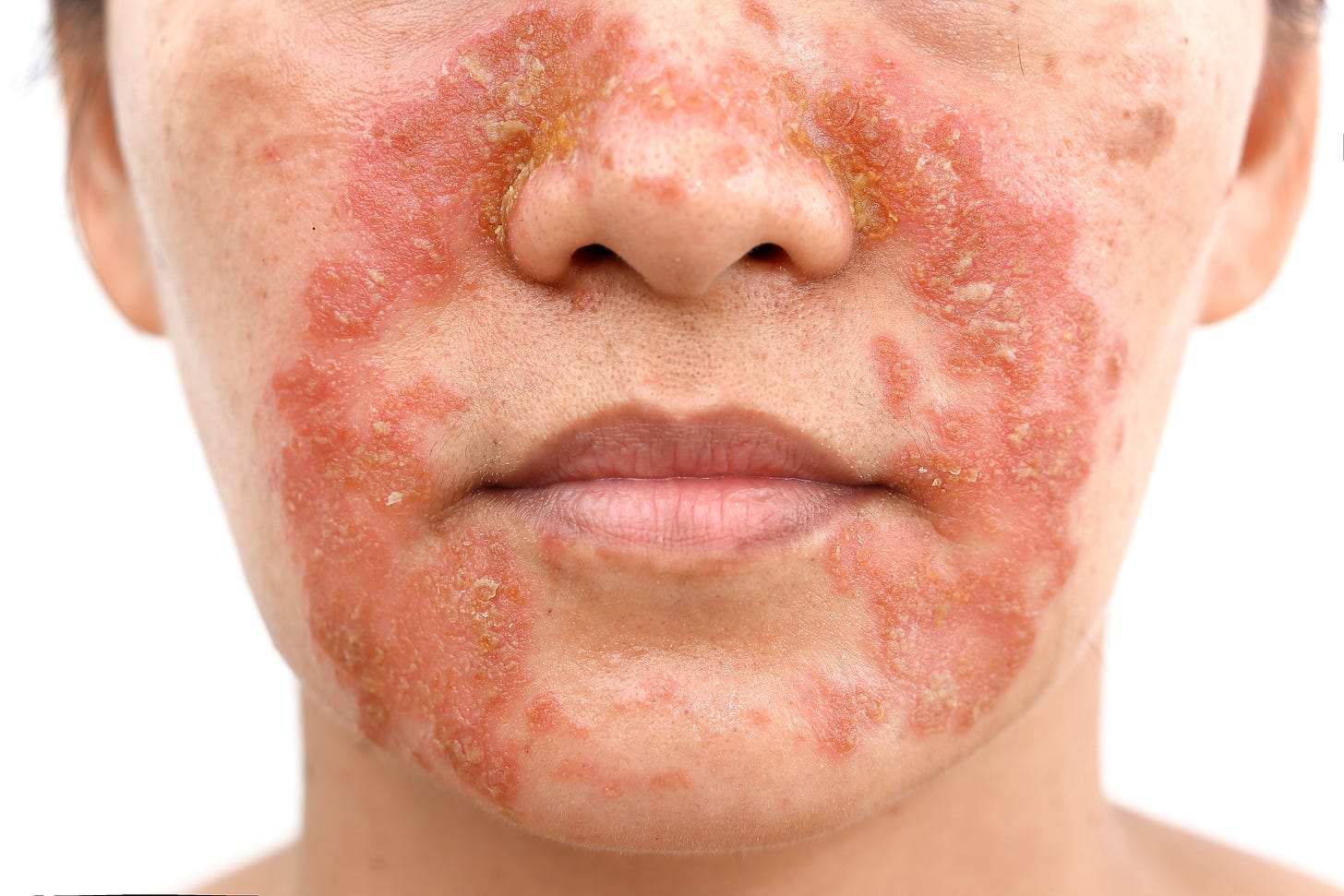Interleukin 23 inhibition associated with lower incidence of CV risk factor type diseases
Today's report also covers palmoplantar pustulosis controlled trials, treating plaque psoriasis with tapinarof cream 1%, and more (1,600 words, 6 minutes, 30 seconds)
The Vender on Psoriasis e-newsletter is supported by an unrestricted grant from Sun Pharma Canada
Good morning and welcome to the 17th issue of Special Reports: Skin Spectrum Weekly presents “Vender on Psoriasis.” This series is based on Dr. Vender’s popular column appearing in each edition of The Chronicle of Skin & Allergy, which offers expert commentary and opinions on current clinical developments in PsO. We’d love to get your feedback and suggestions and invite you to be in touch. Please write to us at health@chronicle.org

Interleukin 23 inhibition associated with lower incidence of CV risk factor type diseases
Psoriasis is associated with an increased risk of cardiovascular (CV) comorbidities, including dyslipidemia, hypertension, diabetes, and major adverse cardiovascular events (MACEs). While biologic therapies are established for improving psoriatic disease and reducing MACEs, their impact on the incidence of CV risk factors among patients with psoriasis remains unclear. In this retrospective study, the association between biologic therapy initiation—specifically tumour necrosis factor inhibitors (TNFi), interleukin-17 inhibitors (IL-17i), interleukin-12/23 inhibitors (IL-12/23i), and interleukin-23 inhibitors (IL-23i)—and the risk of incident dyslipidemia, hypertension, diabetes, and MACEs in patients with psoriasis was evaluated (J Am Acad Dermatol 2025 Feb; 92(2):337-340. doi: 10.1016/j.jaad.2024.09.063). Using TriNetX data (2014–2024), adults (18–90 years) with newly diagnosed psoriasis and no prior history of dyslipidemia, hypertension, diabetes, or MACEs were identified. Patients initiating biologic therapy were propensity score matched 1:1 to biologic-naïve controls based on demographics, social determinants, comorbidities, and medication history. Incidence of new-onset CV comorbidities and MACEs was assessed over up to 10 years of follow-up. Odds ratios (OR) with 95% confidence intervals (CI) were calculated.
After matching, 6,903 patients were included in each cohort. IL-23i users demonstrated significantly lower incidence of dyslipidemia (6.0% vs 14.2%; OR, 0.39; 95% CI, 0.30–0.50), hypertension (4.6% vs 12.4%; OR, 0.34; 95% CI, 0.26–0.45), diabetes (2.3% vs 5.9%; OR, 0.37; 95% CI, 0.25–0.55), and MACEs (1.5% vs 5.9%; OR, 0.24; 95% CI, 0.15–0.38) compared to biologic-naïve controls. IL-17i users had reduced risk of dyslipidemia (8.2% vs 12.1%; OR, 0.65; 95% CI, 0.50–0.84) and diabetes (3.9% vs 5.7%; OR, 0.67; 95% CI, 0.47–0.97), but not hypertension or MACEs. TNFi users exhibited lower dyslipidemia risk (10.0% vs 13.0%; OR, 0.75; 95% CI, 0.64–0.87), with no significant effect on other outcomes. IL-12/23i showed no significant differences.
In direct comparisons, IL-23i users had lower risk of dyslipidemia (OR, 0.69; 95% CI, 0.52–0.90), hypertension (OR, 0.47; 95% CI, 0.35–0.63), and MACEs (OR, 0.43; 95% CI, 0.26–0.72) versus users of other biologic classes. TNFi users had higher risks for all outcomes compared to other biologics. No significant differences were observed for IL-17i or IL-12/23i compared to other biologics.
IL-23 inhibition was associated with a markedly lower incidence of CV risk factor diseases and MACEs compared to both biologic-naïve patients and users of other biologic classes. These findings suggest IL-23i may offer additional benefit in reducing CV comorbidity risk among patients with psoriasis. Limitations include potential selection bias, unmeasured confounders, and lack of disease severity data.
Comment: This large real-world study analyzed over 13,000 adults with newly diagnosed psoriasis to see whether different types of biologics affect the chance of developing common cardiovascular problems like high cholesterol, high blood pressure, diabetes, or heart attacks. Among the biologic groups, IL-23 inhibitors stood out with the lowest rates of new-onset cardiovascular and metabolic conditions—even better than other biologic options like TNF or IL-17 blockers. Patients on IL-23 inhibitors had up to 75% lower odds of developing some of these conditions compared to those not on biologics.
My take: We’ve long known that psoriasis is more than skin deep—it carries systemic inflammation and an increased heart disease risk. This study strongly suggests that IL-23 inhibitors might not only control psoriasis effectively but also reduce the chance of developing heart and metabolic conditions down the road. It makes me think more carefully about choosing IL-23 inhibitors, especially for patients with early signs of metabolic syndrome.

A systematic review of recent randomized controlled trials for palmoplantar pustulosis
Palmoplantar pustulosis (PPP) is a chronic, relapsing inflammatory dermatosis characterized by sterile pustules on the palms and soles, leading to significant functional impairment and reduced quality of life. Despite its rarity, PPP is frequently refractory to traditional therapies, and there is a lack of consensus regarding optimal management. This systematic review critically appraises recent randomized controlled trials (RCTs) published from 2018 to April 2024, evaluating the efficacy and safety of emerging therapeutic modalities for PPP, including phototherapy, systemic agents, and biologics (Journal of Dermatological Treatment 2024; 35(1): 2414048).
A comprehensive literature search identified 13 RCTs involving 1,064 participants, focusing on phototherapy (psoralen plus ultraviolet A [PUVA], excimer laser), systemic immunosuppressants, and targeted biologic therapies. Outcome measures varied across studies, with most reporting improvement in the Palmoplantar Pustulosis Area and Severity Index (PPPASI), as well as rates of PPPASI-50, -75, and -90 response.
Excimer laser phototherapy at high doses (6× minimal erythema dose [MED]) demonstrated robust efficacy in severe PPP, achieving PPPASI-75 in 95% of patients, with an acceptable safety profile. PUVA combined with retinoids (re-PUVA) or fumaric acid esters (FAE-PUVA) was effective in milder PPP, with PPPASI-90 rates of 90% and 81.8% at week 14, respectively. FAE-PUVA provided more sustained long-term clearance compared to re-PUVA, with both regimens being well tolerated.
Regarding systemic therapies, apremilast (phosphodiesterase-4 inhibitor) showed significant efficacy, with PPPASI-50 achieved in 78.3% of patients at week 16 versus 40.9% for placebo (p=0.0003), and PPPASI-75 in 43.5% versus 15.9% (p=0.0074). Efficacy was maintained through 32 weeks, and adverse events were mostly mild gastrointestinal symptoms.
Guselkumab (IL-23 inhibitor) outperformed placebo in multiple RCTs. At week 16, PPPASI-50 was achieved in 57.4–60% (100 mg dosing) versus 21–34% with placebo. Long-term extension showed sustained responses: at week 84, PPPASI-50 was achieved in 88.9–95.3% and PPPASI-75 in 68.9–81.4% of guselkumab-treated patients. The safety profile was favorable, with similar rates of mild adverse events compared to placebo.
Brodalumab (an IL-17 receptor A inhibitor) demonstrated rapid and significant efficacy: at week 16, PPPASI-50 was achieved in 54% versus 24.2% for placebo, with a mean PPPASI reduction of 13.73 versus 8.45 (p=0.0049). Infections were the most common adverse event.
Secukinumab (an IL-17A inhibitor) did not meet the primary endpoint at week 16 (PPPASI-75: 26.6% vs. 14.1% for placebo), but long-term extension to 148 weeks showed continued improvement (PPPASI-75: 78.3–100%). Safety was consistent with known profiles.
Anakinra (an IL-1 inhibitor), spesolimab and imsidolimab (IL-36 inhibitors), and RIST4721 (an CXCR2 inhibitor) failed to demonstrate significant efficacy over placebo and are not recommended as first-line agents.
Emerging therapies such as Janus kinase (JAK) inhibitors and TYK2 inhibitors, though not formally evaluated in RCTs included in this review, show promise based on case series and small studies, with complete or near-complete clearance in up to 53% of cases. However, their safety profile, particularly regarding infection and thromboembolic risk, warrants caution.
Comment: Palmoplantar pustulosis (PPP) is a stubborn and disabling form of psoriasis affecting the hands and feet. This review looked at 13 randomized clinical trials published since 2018 to assess which treatments really work. Guselkumab and brodalumab (both injectable biologics) showed meaningful improvements in symptoms, especially over the long term. Excimer laser and PUVA phototherapy also had strong results. Apremilast, an oral medication, helped in milder cases. However, some new drugs targeting IL-36 or IL-1 didn’t show much benefit. A few newer classes (like TYK2 inhibitors) look promising but still need more formal studies.
My take: PPP can be a real challenge in clinic—it’s painful, affects function, and often resists typical treatments. This review reassures me that we now have viable, evidence-supported options like guselkumab. It’s also a reminder to set realistic expectations and avoid chasing newer agents that haven’t yet proven effective in this population.

Treat-to-target outcomes with tapinarof cream 1% in Phase 3 trials for plaque psoriasis
Treat-to-target strategies in psoriasis management emphasize achieving stringent clinical endpoints, such as ≤1% body surface area (BSA) involvement or low absolute Psoriasis Area and Severity Index (PASI) scores, as recommended by the National Psoriasis Foundation (NPF) and the European Academy of Dermatology and Venereology (EADV). While these targets are often unmet with conventional topical therapies, tapinarof cream 1%—a nonsteroidal aryl hydrocarbon receptor agonist—has demonstrated efficacy in plaque psoriasis. This pooled analysis evaluated the proportion of patients achieving treat-to-target outcomes with tapinarof cream 1% once daily (QD) in the PSOARING phase 3 clinical program (Cutis 2024 October; 114(4):122-127, E1. doi:10.12788/cutis.1112).
Data were pooled from PSOARING 1 and PSOARING 2 (12-week, randomized, double-blind, vehicle-controlled trials) and PSOARING 3 (up to 40-week open-label extension). Analyses included 915 adults (mean age 50.2 years; 58.7% male) with mild to severe plaque psoriasis (PGA ≥2, mean baseline PASI 8.7, mean BSA 7.8%). Patients received tapinarof cream 1% QD, with intermittent or continuous dosing in the extension phase based on clinical response. Primary endpoints were the proportion achieving (1) ≤1% BSA affected and (2) absolute PASI scores ≤3, ≤2, and ≤1. Time-to-target analyses utilized Kaplan-Meier estimates.
At three months, 40% of patients achieved the NPF-recommended target of ≤1% BSA affected; 61% achieved this threshold at any time during the study (median time to target: ~four months). Additionally, 50% achieved a more stringent target of ≤0.5% BSA (median: ~6.5 months). Regarding PASI outcomes, 75% achieved an absolute PASI ≤3 (median: two months), 67% achieved PASI ≤2 (median: three months), and 50% achieved PASI ≤1 (median: six months). Efficacy was observed across the spectrum of baseline disease severity. Tapinarof demonstrated durable responses, with no evidence of tachyphylaxis and a remittive effect of approximately four months off therapy. The safety profile was favourable, with most adverse events being mild or moderate and not leading to discontinuation.
Results showed that tapinarof cream 1% QD enables a high proportion of patients with mild to severe plaque psoriasis to achieve or exceed ambitious treat-to-target endpoints, including those typically reserved for systemic or biologic therapies. These findings support tapinarof as an effective, durable, and well-tolerated topical option for achieving optimal disease control without restrictions on duration, extent, or application site.
Comment: Tapinarof is a novel topical cream that’s steroid-free and works through the aryl hydrocarbon receptor pathway. In pooled data from phase 3 trials, many patients with mild to severe plaque psoriasis were able to reach goals that are usually reserved for systemic treatments—like reducing body surface involvement to less than 1%, or achieving very low PASI scores. What’s even more impressive is that the results lasted well beyond the treatment period for many patients, with no signs of the skin getting used to the drug or losing effect.
My take: We’ve been waiting for a high-performing topical that doesn’t come with steroid baggage—and tapinarof delivers. It’s an exciting option for patients who don’t want or can’t tolerate systemic drugs but still want results that go beyond "just good enough." This may reshape how we treat patients who fall in the moderate disease gap.

If you find the contents of this newsletter interesting, please check out the Vender on Psoriasis podcast. It’s available at Apple iTunes, Stitcher, Spotify, or wherever you get your podcasts.
Dr. Ron Vender is a Hamilton-based certified dermatologist with over 30 years of clinical practice experience and over 100 clinical trials in psoriasis. He is founder and director of Dermatrials Research Incorporated and Venderm Consulting, specializing in treatments and management solutions for individuals with psoriasis.
Subscribe to The Chronicle of Skin & Allergy
Established in 1995, The Chronicle of Skin & Allergy is a scientific newspaper providing news and information on practical therapeutics and clinical progress in dermatologic medicine.
To apply for a complimentary* subscription, please email health@chronicle.org with your contact information or click the link below.






